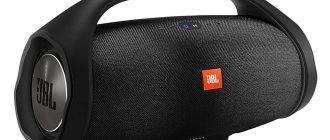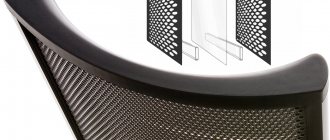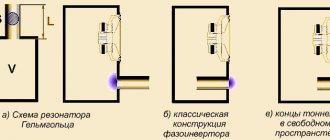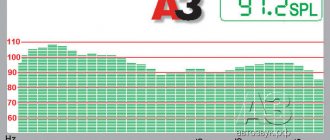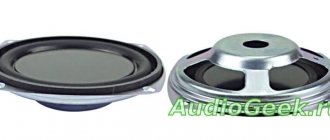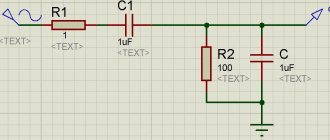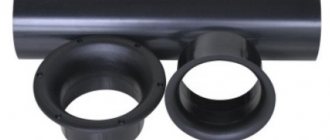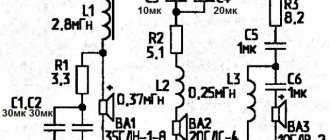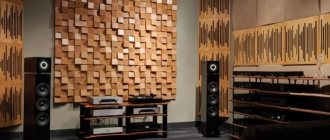began selling so-called “acoustic kits” (KITs) - kits for the self-assembly of full-fledged acoustic systems (7 varieties). The kit includes a ready-made case, audiophile-grade speakers and components, wires, and detailed assembly instructions. As he assures. We had a chance to try out the KIT02 and KIT03 sets in action.
Save and read later -
Concept
A serious Hi-Fi/High-End speaker system requires a high-quality housing, audiophile-grade speakers and electronic components, plus skilled manual labor, the ambitions of the manufacturer, logistics and marketing costs... Hence the correspondingly high prices for finished products.
Therefore, many craftsmen (able to hold a screwdriver, soldering iron and other tools in their hands) reasonably ask the question “why overpay when you can buy parts and do everything yourself”? And they set off to swim in home acoustic architecture... However, assembling speakers on your own “from scratch” is a very non-trivial task, requiring experience, special tools and expensive measuring equipment. Of course, there are enthusiasts who are determined to “experience the zen” of creating a completely independent speaker system. Let us immediately note that the proposal considered in the review is most likely not for them.
The proposed “Constructors” are essentially ready-made speakers (developed, assembled and tested by the laboratory of Yuri Fomin, creator of acoustics from the Arslab and Old School brands), but not past the final assembly stage. Accordingly, this solution is aimed specifically at music lovers and audiophiles who want to get “high sound” while spending a minimum of money and time.
Indeed, Audiocore “whales” are made up of audiophile-grade components (SEAS, Jantzen, Mundorf - these names say a lot to High-End enthusiasts) - branded speakers using components of the appropriate level cost several times more (from 100,000 rubles and more). What is fundamentally important is that the kit includes a completely finished speaker enclosure of factory quality assembly and finish.
The housing, speakers and components are precisely calculated and coordinated with each other. The user can only put everything together using basic craftsmanship skills.
Acoustic systems Troels - DIY Hi-End
I didn't think anything good when I heard the term "homemade acoustics", but my recent experience is truly amazing. If you wish, you can find many designs of acoustic systems on the Internet, there is only one problem, you cannot know how they actually sound in comparison with industrial products, and you cannot believe what is written about them, since these are only unfounded statements of interested persons Last week I was on a visit where I was able to listen to homemade acoustics from Troels Gravesen.
At first, I ignored the words “homemade acoustics”, because I thought that it would be something simply terrible, since the rest of the path was of a rather low level. The audition made sense, also because I took with me two more than familiar-sounding mid- and high-class amplifiers - the Sansui a607 (1986, 79,800 yen) and the Onkyo M-506R power amplifier (retail price in 1981, 170,000 Japanese yen). The speakers I listened to were built on the basis of data from the site https://www.troelsgravesen.dk In general, there is a little semantic information. Troels Gravesen is a Danish designer of high-end Hi-End acoustic systems. He develops Hi-End class acoustic systems, i.e. selects speakers, calculates housings and filters, and posts them on the Internet for the benefit of the DIY community.
Troels actively participates in various Hi-End exhibitions (for example, the Munich Hi-End Show) with his products.
You can buy ready-made kits of Troels acoustic systems from a number of foreign companies or assemble them yourself by purchasing them in various stores. How exactly Troels receives income from his activities is not important, whether whale producers pay him some percentage or whether he forms such whales himself. What matters is how good these systems are. I was recently able to listen to Troels' system. This is a fairly tall Jenzen NEXT model.
Acoustics on Seas speakers (Excel, CRESCENDO, etc.). The speakers are classified by the manufacturer Seas as Ultra Hi-End. The speaker systems themselves are quite impressive in size, they are deep and quite wide. I listened to speakers similar to those in the picture above, but with a slotted bass reflex:
The body was made independently and covered with veneer. The overall appearance turned out great, completely standard. The owner of the acoustic systems said that the main problem arose in creating holes for the speakers, since sawing the material was not difficult - any sawing can do this, but everyone refused to cut round holes, so I had to take on this task myself and cut it out with a hand cutter. The result was excellent. The cutter also helped a lot in cutting the edges of the veneer, since otherwise it would have turned out uneven and imperfect. If possible, I will ask the owner of these rare speakers to tell me the details, but for now, take this material as an introduction. When listening to acoustic systems developed by Troels, a couple of seconds were enough for me to determine the sound class. Yes, this is truly a fierce Hi-End. I have listened at home or with friends to quite expensive, well-known acoustic systems with excellent reviews, look for yourself - Diatone DS-3000 (520,000 yen in 1984), Klipsh Heresy 2, Tannoy Prestige, etc., but these Troels Next are on a completely different level , this sound is much higher class. It is not surprising that, as the owner of the speaker told me, when he listened to acoustics costing 150,000 rubles in a store, he could not hide his disappointment by saying, “Well, it plays so poorly,” causing bewilderment among the Hi-Fi store salespeople. Firstly, NEXT has a lot of air and space. The speakers stretch even the most nerdy components to an incredible level, what can we say, what will happen if you connect at least Onkyo 506 or higher to them?
Onkyo M-506R
In principle, everything was against these speakers, the source was a Marantz 7004 CD player and a Teac UD-301 DAC, the amplifiers were changed from Sansui 607 to Onkyo 506R. And the level of these speakers is clearly higher than the capabilities of these devices. But despite this, the acoustics deliver a very natural and rich sound, with fields made of air and simply the wildest ultra-high resolution. Imagine that you are sitting by a stream and admiring through the crystal clear water its sandy bottom covered with algae. And suddenly you are shown that it can be much more transparent than you can imagine. What I liked was that it was the first fabric tweeter that I had heard before, which was in no way inferior to metal ones.
Acoustics with phenomenal sound, very deep real Hi-End. But Troels has speakers of a higher class. Let's look at the filling. Let's start with the speakers and approximate prices for them. SEAS Excel E0040-06 (T29CF002) Crescendo-20315 * 2 = 40630 SEAS Excel E0046-08S - 21165 * 2 = 42300 and woofer - approximately 25-30000 *2 According to the owner, with delivery and other things, his cost was approximately 130,000 rubles for speakers. He specifically chose the Seas speakers, and not the Scan Speak, because he likes the Seas. Now imagine what they offer you in a store for branded acoustics, which at 100-150,000 rubles already contains a bunch of speakers of an incomprehensible class and a wild markup for the brand, housing, etc. And now feel the abyss in quality compared to those acoustics and acoustics from Troels.
Columns according to Troels calculations
But that is not all. Troels, as an experienced developer, claims that there are very few speakers that can get by with a simple filter (what we see in branded acoustics is a pair of capacitors, resistors and a coil). Troels also has designs with a simple filter, but speakers that can work well with such filters are very expensive. And what you see in branded acoustics is a very big financial compromise based on crap speakers and nothing more.
Speakers according to Troels' calculations
Therefore, Troels' designs generally contain very sophisticated crossovers (filters) that correct all the shortcomings of the speakers, bringing the speaker system into the Ultra Hi-End league.
Estimate the size of crossovers on the floor
So, the filters in Troelsov’s speakers are not nonsense in terms of financial costs, he offers both simple and better options. In the best options, the cost of parts for a crossover starts from $5,000-6,000.
This crossover is huge
The owner of the Next acoustic system I was listening to said that his crossover was more expensive than the entire set of speakers, and at the same time he tried to cheat, install simpler coils, not with a metal core, etc., but the sound immediately degraded and it was clear that he needed to at least stick to the minimalist specifications from Troels for parts.
Everything is honest, without a catch, you want better, you need to invest more.
You may also be perplexed when you hear what costs are needed for a crossover, but I think many people by the word crossover mean regular-sized capacitors.
Just imagine a pile of capacitors, each the size of a fist, coils the size of a good toroidal transformer, and then it will become clear to you that many have simply never seen such parts in their lives. These are components from another Universe.
As a result, I can only assume that even taking into account the self-manufacturing of the case and the soldering of the crossover with my own hands, the cost of the NEXT speakers I listened to was approximately 300,000 rubles. This is the cost of parts. How much do you think similar branded speakers will cost? I’m unlikely to be mistaken in calling their price tag 1.5-2 million rubles. Although I am too modest in my assessment, for example, WILSON AUDIO Alexia, priced at 4.5 million rubles, does not resemble anything?
WILSON AUDIO Alexia
Discovery 4 by Troels
Those. It really turns out to really become the owner of extra-level acoustics. And these are not millions, but although very high, they are achievable expenses. Perhaps gradually, first you buy speakers, after a year or two a crossover, then a body, and so on. But if you want, you can do it. Actually you can. The owner of these speakers did not have any special skills, but he had a very great desire and simply followed the detailed instructions on the Troels website. I was really impressed by the sound of these speakers. I would be glad to collect these, but seeing the range of expenses, I understand that it is not yet in my capabilities, although I will begin this movement towards good acoustics by putting up for sale my very airy JBL 4312B MK II Control Monitor. Troels also has small shelf books of the same Hi-End level. Yes, one tweeter in them costs 26,000 rubles, i.e. for a couple, only the tweeters reach 52000.
Troels writes that he is sorry to see how people listen to all sorts of junk and therefore he specially designed inexpensive speakers with really good sound Discovery 12W:
Those. the main question is whether speakers made independently can be very good, Hi-End class, as you can see the answer - they can, if you follow the recommendations of the famous Ultra Hi-End developer. And there is no doubt about how good these designs sound either; the Next model we listened to sounds incredible even on simple equipment, and in a higher path it begins to play with new facets, striking in timbral depth.
I think this is not the last material on this topic, if you have something to say, share information and impressions on our forum.
Assembly
We twist the legs of the crossover elements together (according to the attached diagram and photo of the finished crossover), solder everything and connect it to the output terminals. We place the acoustic absorber into the housing (included in the kit). We install the speakers - they are screwed with screws (with self-tapping screws - we remove them, there are ordinary screws) to the body (all the mounting holes are already provided and the cage nuts are in place). We also attach a platform with output screw connectors to the body. Connect to the amplifier. Warming up. Let's listen and enjoy. In principle, everything is simple. Well, those who are “in the know” are offered some scope for creativity (author’s taste tuning) - the space behind the speakers can be additionally damped with natural wool or some other material. “Options are also possible” for complete filter elements, bi-wiring connections and other bells and whistles.
Design
At the moment, “Audiomania” offers 7 different modifications of “whales”, differing in their elemental base. All speakers are bookshelf, two-way. There are two body options - 10.6 or 19 liters. All speakers are made by SEAS. Crossover elements are audiophile components from Jantzen, Mundorf and Audiocore. Screw terminals - WBT. The selection/coordination of speakers and components carried out by the manufacturer (in different “whales”) determines the character and “zest” of the sound of each modification - the user can choose exactly the sound that suits him best in terms of the scale of the “bass” stage and the balance between detail and musicality.
In the box
In this test I'll be looking at two Audiocore kits - the entry-level KIT01 and the slightly larger KIT04. Both sets are supplied in two neat boxes made of thick cardboard. One of them contains dust nets and housings with a volume of 10.6 and 16 liters. The other contains detailed step-by-step instructions with photos and components, including speakers, acoustic terminals, wires, crossover parts, seal, acoustic absorber and screws. It is worth noting that the listed elements were selected without the slightest hint of economy. Everything is done in such a way that the buyer not only feels the advantage of the proposed solutions, but can also start listening as soon as possible. However, first he will need a screwdriver, a soldering iron and time to assemble. However, the assembly can also be ordered in the store.
Audiocore KIT04 on the test bench
It would seem much easier! After familiarizing yourself with the design, buy all the listed elements separately and assemble the same exact speakers from them. But no, individually everything turns out to be more expensive, and given the cost of the cases, which will be discussed below, the idea completely loses its meaning. By the way, making a body yourself involves engineering calculations, selection and testing of materials. This requires experience and hands that grow from where necessary. Whereas Audiocore offers everything ready-made - and this is the uniqueness of the offer. A beautiful cabinet with veneer trim, already designed for this set of speakers, guarantees that the resulting speakers will look decent and play decently.
Audiocore KIT01 on the test bench
At the same time, I was a little disappointed by the absence in each of the sets of such obvious trifles as solder and glue, or clamps for fixing parts on the crossover board, which the future owner will have to purchase on his own. And although the manufacturer’s desire to provide the buyer with freedom in choosing these components is quite understandable, the presence of the latter would hardly significantly increase the cost of the kit. In addition, it would be much more convenient if photos or outlines of parts for surface mounting on a 1x1 scale were printed directly on the crossover board itself. I think this would increase the accuracy and speed of assembly, and also slightly liberate buyers who doubt their abilities. Unfortunately, I didn’t have to assemble the speakers myself: they were already assembled, warmed up and prepared for the test.
Sound
Listening to speakers assembled from Audiocore KIT02 / KIT03 “constructors” (we compared and tried two options) took place in the prepared “Audiomania” showroom.
Reference system used: CD player - Atoll CD100, Integrated amplifier - Atoll IN300
Cables: ColdRay Interconnect Line AG (interconnect) ColdRay Loudspeaker Line CU (acoustic) Furutech FP-314Ag and CLS Power Zero MKII (power)
Power filter – Furutech e-TP80
Stand – ColdRay Base
Yes, both “whales” delight with their interesting, “thoroughbred” sound. The volume/depth of space is felt, clear images are drawn, there is life and drive in the game. Of course, the “detachment” of the sound from the loudspeakers is intriguing - an important evidence of the speakers’ belonging to the “upper class”. If we compare both options and give figurative “allegories”, then KIT02 is a thin, light and seemingly very fragile ballerina. She dances agilely and easily, masterfully performing complex and sophisticated pirouettes. There is a lot of light, detail and clarity in the handwriting, but somewhere there is a little lack of strength and drama, which is completely natural with this “composition”. The presented heroine prefers small, intimate spaces rather than large concert halls. In the rather spacious Audiomania showroom in the KIT02 game, there was some lack of bass response - most likely, in a small but cozy office, the sound would be more intriguing and bewitching.
As for KIT03, it is appropriate to compare this acoustics with a fitness woman who is athletically built and regularly visits the gym. Energetic, smooth, sedate, confident, correct. Yes, there is not the grace and sophistication of the KIT02, but definitely the sound here is more “meaty”. The “pumped up” bass register is harmoniously complemented here by a slightly more energetic tweeter that is adapted to high loads (than that of the KIT02). In the conditions of the spacious Audiomania showroom and the electronic components involved, the sound of the KIT03 seemed to us more interesting and expressive.
Audiocore KIT02.1 and KIT05 assembly kits
You don’t have to be a great specialist to understand the principles of pricing in the production of speaker systems. One of the most expensive items in production is assembly, especially manual ones. But you can save money on this by choosing a kit for building your own speaker systems instead of a finished product. Such, for example, as Audiocore KIT02.1 or KIT05. We took both so as not to waste time on trifles...
The DIY movement, which is popular all over the world (short for “Do It Yourself”), for some reason has not received mass support in our country and only glimmers among a narrow circle of do-it-yourselfers. This is strange to say the least. In the wealthy American States and Europe, for some reason, enthusiasts do not hesitate to buy “whales” and take up tools in order to create something necessary and beautiful on their own, but in our country they prefer ready-made things.
In addition to the interest in making speakers with your own hands, there is another strong argument in favor of designers: price. This is exactly what they bet on in “Audiomania”, taking one of the principles of “Ikea” and designing seven quite affordable, but very advanced in audiophile terms, sets. And according to my estimates, only due to the fact that most of the assembly operations will be carried out not by a worker at the factory, but by you at home (which will take at most half a day), you will save an amount that is quite enough for decent speaker cables.
The affordable price of the kits is achieved primarily through unification. Cases made of MDF, well decorated with natural veneer and made according to all the canons (with internal spacers and bitumen damping of the walls, with cage nuts for the fastening screws of the heads), are available in two sizes. The smaller ones, with an internal volume of 10 liters, are equipped with four sets: KIT01 and KIT02, which differ in mid-bass drivers, and, accordingly, KIT01.1 and KIT02.1 with other tweeters. The larger 19-liter versions have the same tweeters, so the kits are called KIT03, KIT04 and KIT05 and differ in bass/midrange speakers and crossovers.
All heads are exclusively SEAS. This is explained not at all by the desire to work with one supplier, but by the fact that it is Norwegian components, judging by foreign forums, that are most popular among home-made manufacturers. Moreover, for the “whales” from the wide SEAS range, the heads were selected not only by cost, but also taking into account the reputation and preferences of audiophiles. Some may be prejudiced against polypropylene diffusers, while others may be convinced that a tweeter must have a return chamber. That is why the à la carte option is offered...
Assembly? No problems are expected. All you need is a screwdriver, a tool for stripping insulation, and a regular soldering iron with a power of 60 watts. You also need to stock up on special glue in advance (polymer hot melt adhesive is also suitable if it reliably sticks to MDF), rosin and high-quality solder.
Each “kit” is a single package with ready-made housings and a package with all the necessary components, including a cable for internal wiring, a padding polyester sound absorber and blocks with WBT terminals. Buy-wiring is not provided, otherwise the manufacturer would have to save on the quality of terminals in order to keep the price at an acceptable level. For the same reasons, there is no printed circuit board for the separating filter - it is replaced by a platform made of 7 mm fiberboard for wall-mounted installation. This results in better damping and fewer solderings - this was done not out of economy, but according to high-end canons.
Here I must make a reservation that I was offered to first listen to the already assembled and “kneaded” sets in the reference system, and only then get acquainted with the details of the sets. I didn’t mind - the “black box” principle is always more interesting and often allows for more accurate subjective assessments. And in order to reduce the “systemic” factor, along with the proposed source, I also used one that is well studied.
The first to be placed on the racks are KIT02.1. They impress with their clarity and precision in the high range. A seemingly ordinary textile tweeter sounds its spectrum as if it is trying to decompose the sound of all cymbals and other sonorous instruments into the smallest components. Complete realism is hampered only by slight compression of the sharpest plucks and blows of the sticks, although this does not spoil the overall impression and even adds accuracy to the sound. The 3-5 kHz region is slightly muted, but the highest frequencies are not overwhelmed (and such a sin is often found with soft-dome tweeters). The main thing is that nothing interferes with the perception of volume and “air”. The spatial data is in perfect order. The localization is accurate, the “highs” do not stick to the speakers, and clearly defined images are formed in the depths of the stage. The middle is quite linear and temperamentally maintained in the same vein as the high range - microdynamics are best expressed. Minimum touch ups. There are no cabinet, bass reflex, or diffuser overtones. At the same time, the acoustics easily tolerate high volume levels, maintaining, even in the “afterburner” mode, the analytical rather than the emotional nature of the playback. Connoisseurs of nuances and timbral precision will appreciate these qualities highly. But for lovers of drive and “meat”, I’m afraid this will not be enough, although the KIT02.1 is quite impressive in the lowest range. The bass reflex effectively helps the small head pick up bass from 50 -60 Hz. Especially in cases where stands with monitors are placed closer to the wall.
What is KIT02.1 made from? The set contains two Jatzen coils, three film capacitors and resistors labeled Audiocore. The HF crossover is of the second order with an L-shaped attenuator; a somewhat unusual filter is used in the low-frequency section (seemingly of the second order, but with a resistor connected in series with the capacitor) - such a circuit can give a slight increase in the frequency response near the crossover frequency. The description is silent about its meaning, but modeling the filter values for the known parameters of the heads shows that the bands are divided somewhere around 4 kHz. And the most interesting thing: drivers. The dome 27TFF is a rather rare representative of “dry” tweeters today - it does not have ferromagnetic fluid in the gap, and the damping of a lightweight moving system with an aluminum coil is carried out by a reverse chamber. The 15cm ER15RLY is responsible for the mids and bass. This is a head with a cast basket and a diffuser made of cellulose reinforced with reed fibers. And like any heads with a light and free driver designed for long strokes, it is certainly sensitive to internal damping. For those who are assembling their own pair, I advise that after 100-200 hours of “breaking in” the speakers, we advise you to unscrew the midwoofers and select the required amount of padding polyester by ear. I am sure that with such a simple setup you can achieve an expressive drum attack without losing bass intelligibility.
KIT02.1
KIT05
The second pair for the test is the larger KIT05 monitors. The sound is the complete opposite of “twos”. They reproduce music lively, playfully and without the slightest stiffness. The impact is very sharp and clear, although without much fullness from the lowest frequencies. Rearranging the speakers closer to the wall adds energy - buzzing or resonant sounds do not bother you. The images in the scene are almost material and not overblown. High frequencies are rather restrained, although very expressive in dynamics. The detailing is no worse, for example, than that of KIT02.1, but they convey complex spectra and powerful contrasts more freely, cleaner and more natural. I would rate the linearity in the high band as exemplary, if not for a slight roll-off above 14 - 15 kHz (caused, rather, by external factors - a room with a high degree of sound absorption). Some complaints remain only halfway through. On the one hand, I want to attenuate the 1 - 3 kHz band, which I can easily do using the parametric equalizer in the software player. On the other hand, it’s a pity - it is at mid frequencies that the KIT05 extracts so much realistic information from music that monitors from a much higher price segment fade next to them. Any vocals, saxophone, guitar – amazing! But a large orchestra begins to sound, and unnaturally accented violins appear.
Let's look at the set's configuration. Each “five” is equipped with a high-quality 29TFF/W tweeter from the Prestige series. This is a head with a tricky concave flange, an increased suspension and an aluminum coil, which is cooled by a low-viscosity ferromagnetic fluid. According to the passport data, the tweeter almost linearly reproduces the range almost from the resonance frequency (about 1 kHz), although the manufacturer recommends turning it on through a fourth-order Linkwitz-Riley filter of at least 2 kHz. The 18-centimeter midwoofers have a very light paper cone diffuser with a special coating and are equipped with a powerful magnetic system. In the parameters of the latter, attention is drawn to the unusually high internal inductance of the voice coil.
What about filters? The kit includes four capacitors, two inductors and two resistors. Instead of the recommended filter with a slope of 24 dB per octave, the developers put the second order on HF (choosing a higher frequency - 2700 Hz), but with a series inductance capacitor. Such a circuit works as a notch filter - it dampens the signal at a certain frequency (according to calculations - somewhere at 740 Hz, i.e. outside the tweeter range). Its purpose is to provide a greater steepness of the decline. The crossover for low frequencies is traditional, second order with a Zobel circuit that compensates for the high inductance of the head. But even without calculations, it is striking that the resistance value is much higher than the “Zobel” value, which perhaps explains the accentuated reproduction of mid frequencies. Did the one who designed the filter for the “five” consciously decide to sacrifice formal linearity for the sake of phenomenal resolution in the middle? If my guess is correct, then this is already a “chef’s dish.”
PS Since we are dealing with a constructor where creativity and curiosity are highly encouraged, we will share our own crossover recipe for KIT05, which will help make the sound more neutral. The upgrade is simple, it comes down to changing the values of standard elements.
If for the low-pass filter you select C3 at 68 μF, C4 at 3.9 μF, and R3 at 7.5 ohms, then, as computer simulation shows, the roll-off to the crossover frequency will become earlier and flatter (compensation for the rise at mid frequencies is shown in the graph, where thin lines show the characteristics of the original filters). At the same time, let’s slightly increase the cutoff frequency for the tweeter, choosing C1 equal to 3.9 μF, and R1 equal to 4.7 Ohms. And the final touch: let’s shift the frequency of the oscillating circuit L1C2 to the resonance frequency of the tweeter, placing a 47 µF capacitor in it instead of the standard one. That's all. Take a sample.
PPS We received a comment from Yuri Fomin, the developer of these sets, on the proposed upgrade. He writes: “As for improving the crossover, then, in fact, the set pushes for this. The only thing I would advise is to inform readers that when doing such work you need to have either unique hearing or measuring equipment. Otherwise, they may not get the expected result. The filter we recommend guarantees reliable operation.”
COMPONENTS
- Sources Atoll CD100 player
- laptop Apple MacBook Air A1465
- Schiit Modi Multibit DAC
- Integrated amplifier Atoll IN300
- interconnects RealCable CA1801 (modified) and ColdRay Interconnect Line AG
Audiocore speaker systems
Supplier: Audiocore/World Audio Disctribution (Latvia)
www.audiocore.ru
KIT02.1
Configuration: 2 emitters, 2 bands || Acoustic design: bass reflex || Recommended amplifier power: 25 - 100 W || Finish: black veneer || Dimensions: 320 x 180 x 340 mm || Weight 1 piece: 5 kg || Price per set: 45,000 rub.
KIT05
Configuration: 2 emitters, 2 bands || Acoustic design: bass reflex || Recommended amplifier power: 30 - 150 W || Finish: black veneer || Dimensions: 370 x 220 x 370 mm || Weight 1 piece: 6 kg || Price per set: 54,000 rub.
share
Tags: AudiocoreDo It YourselfKIT02.1KIT05
MAIN
- DIY kit for building your own bookshelf speaker system "Introduction to High-End"
- Carefully selected and coordinated audiophile-grade components: SEAS speakers well known to high-end DIYers (they are used by top acoustic manufacturers), crossover filter components from Jantzen, Mundorf and Audiocore, WBT screw terminals
- Fully assembled MDF body with natural veneer exterior
- Opportunity to “play around” with fine-tuning the sound (selection of sound absorber and components)
- The cost of the presented set is significantly (1.5-2.5) times less than the cost of ready-made acoustics of a similar class
“Acoustic system” designer Audiocore KIT02 / KIT03
Both “homemade products” are distinguished by high acoustic characteristics. There is clear, lively, imaginative, expressive sound with a spacious / spacious stage, accurately focused and positioned voices. The depth and transparency of the space are felt, the “message” of the performers and the sound engineer is conveyed to the listener - the most important attributes of high-end acoustics. Moreover, each of the “whales” has its own specific sound. KIT02 offers a more graceful, aesthetic sound with finely rendered details for solitary, thoughtful and dreamy listening in small apartments - a kind of "elven tale"... KIT03 - a more "earthy", full-bodied and "meaty" sound with a harmonious, well-balanced balance.
Design
— 7
Construction
— 8
Sound
— 9
Price
— 8
TOTAL
— 8
Specifications Audiocore KIT02
Equipment:
- cabinet, woofer, tweeter, crossover components, internal wiring cable, input connectors
Configuration:
- two-way
tweeter:
- SEAS 27TDC (fabric dome on impregnated polypropylene surround)
Woofer:
- SEAS ER15RLY (paper diffuser 150 mm coated, lightweight magnetic system, cast basket)
Frequency range (-3 dB):
- 55 - 20000 Hz
Recommended amplifier power:
- 25 - 100 W
Dimensions (HxWxD):
- 320 x 180 x 340 mm
Weight:
- 8.8 kg
Outside and inside
Based on general statistics of consumer preferences, all seven assembly kits are produced exclusively in black cases. To say that the acoustics look laconic is to say nothing. And although at first glance the speakers are like speakers, something about them attracts attention... Probably the aristocracy of the lines, verified over the years. Massive cabinets, covered with natural black ash veneer, seem to gently settle a person spoiled by bright colors and a variety of shapes, appealing to a serious listener rather than to a viewer content with superficial impressions. Moreover, as you become more familiar with acoustics, this feeling only intensifies.
Audiocore KIT04 with speakers removed
Both pairs of speakers have an acoustic design with a bass reflex, the port is located on the rear panel. Armed with a screwdriver, I looked inside, having first removed the acoustic absorber.
The build quality of the cases is, without exaggeration, very high, which demonstrates a high production culture and respect for the buyer. For example, massive MDF panels are covered with veneer outside and inside. Each building is reinforced with internal partitions; damping bitumen slabs are located on the side panels.
Audiocore KIT04 with speakers removed
Internal wiring is made using the included powerful copper cable made of oxygen-free copper of high purity, produced in-house. To connect the speaker cable, universal WBT terminals are used. Their terminals are screwed on with corrugated caps, which, in terms of tactile sensations, are more associated with high-quality ceramics than with plastic.
An equally pleasant detail for me was the system for attaching the speakers with screws to furniture nuts already pressed into the inside, which allows you to disassemble and reassemble the speakers an unlimited number of times without damaging the cases.
The photo clearly shows the muffling bitumen slabs and the crossover module
Even the dustproof net with an MDF frame covered with black glossy enamel with dustproof fabric neatly attached along the contour is made with such skill that you don’t want to let it go for a long time.
It must be said that the dynamic heads offered in both sets have long and successfully proven themselves to be the best on Western homemade forums. If you look at their amplitude-frequency characteristics, you get the impression that they are literally made for each other.
Audiocore KIT01 assembled
For the Audiocore KIT01 set, electrodynamic drivers from Seas are offered: a 150-mm Seas CA15RLY mid/bass head with a paper cone on a rubber suspension and a Seas 27TDC tweeter with a fabric dome with a diameter of 25 mm on a polypropylene suspension. Components from Audiocore and Jantzen were used as the elemental base for assembling the crossover.
The Audiocore KIT04 set also includes electrodynamic drivers from Seas, but these are a 180-mm Seas ER18RNX mid/bass head with a paper cone on a rubber suspension and a Seas 29TFFW high-frequency driver with a textile dome on a textile suspension with a diameter of 25 mm. As an element base for assembling the crossover, elements from Audiocore, Jantzen and Mundorf were used.
Audiocore KIT04 assembled
Relatively high sensitivity and a convenient impedance of 8 ohms make the speaker systems under test a convenient load for almost any amplifier. In my case it was an Atoll IN 300 amplifier with a power of 150 W per channel. The source was an Atoll CD 100 CD player. The interconnect cable was Cold Ray Interconnect Line AG, the acoustic cable was Cold Ray Loudspeaker Line AG.
Both components were mounted on special anti-vibration mounts from Cold Ray Ceramic, and fractal diffusers from the same manufacturer were placed on top of the amplifier. Frankly, I don’t particularly understand the benefits of these amusing devices, but the fact that in a fit of emotion you won’t accidentally sit on an amplifier is for sure.
Acoustic stands and accessories from Cold Ray were used for listening.
The acoustic systems were installed on Cold Ray S stands in the corners of an isosceles triangle (on the long side of 1.5 and 2 meters) and turned towards the listener. As test material, we will use a traditional set of discs, including EISA tracks.
Specifications Audiocore KIT03
Equipment:
— cabinet, woofer, tweeter, crossover components, internal wiring cable, input connectors
Configuration:
— two-way
Cabinet volume:
— 19 l
Treble speaker:
— SEAS 29TFFW (H1318-06) with Sonomex fabric dome membrane, fabric suspension, elliptical waveguide made of elastomer
Midrange/woofer:
- 6.5″ SEAS U18RNX/P (H1571-08) with a polypropylene diffuser, phase-equalizing bullet and cast metal chassis
Recommended amplifier power:
- 25 - 100 W
Frequency range (-3 dB):
- 48 - 20000 Hz
Power:
- 80 Watt (peak), 250 Watt (long-term)
Dimensions (HxWxD):
- 370 x 220 x 370 mm
Weight (pcs):
- 10.5 kg
